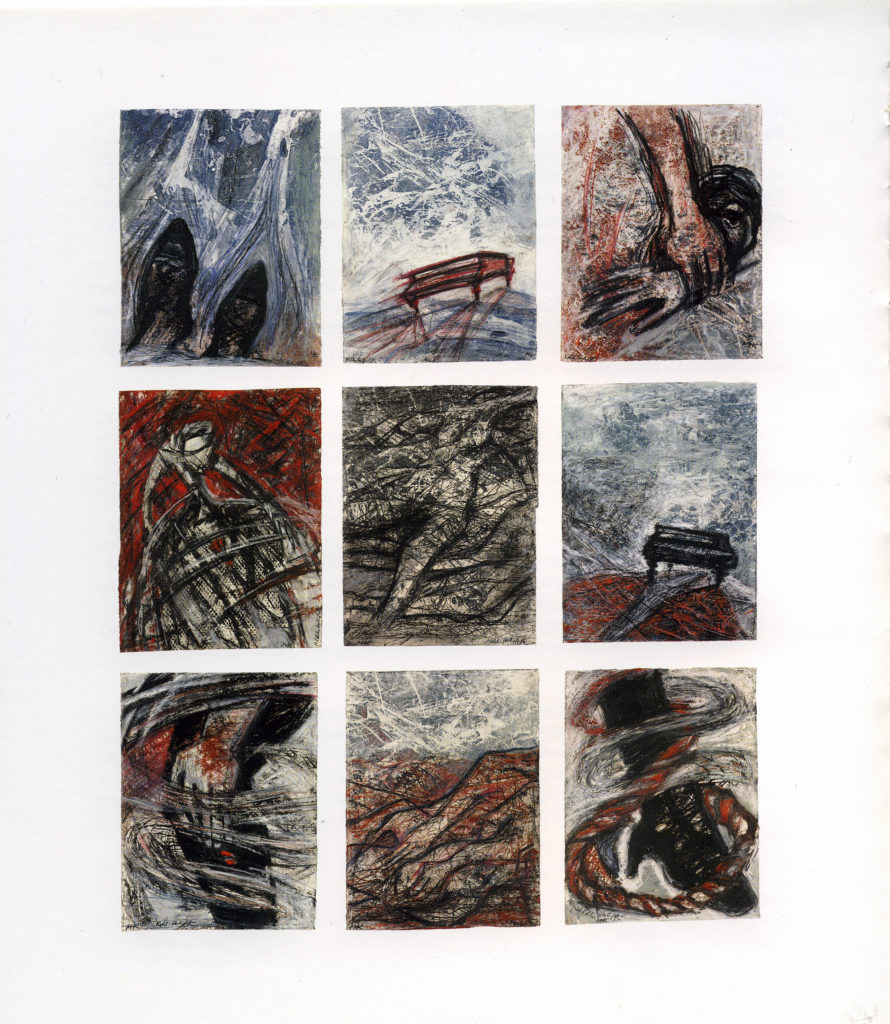Piano-Forte
Mixed media, two Series: Interplay of forces, Dance of forces (multilingual catalogue1999)
In many of Margret Kohler-Heilingsetzer’s works the woman is at the centre of attraction. She is characterized by the variety feelings, from the soft piano to the insistent, unignorable forte. The artist intends to set a complex, interesting and realistic female conception against the often observed attempts of reducing women to a few cliches. In the centre of her artistic activity in recent years there is selfe-experience as a permanent analysis with herself as a woman, as an artist in discussion with her works, the female dialogue with the male principle, the self-realization as a dividing line to the complementing different person.
Margret Kohler-Heilingsetzer, herself an enthusiastic cineaste, was inspired and fascinated by the film „The Piano“ by Jane Campion and so she displayed her own specific view of the problems in her individual artistic techniques. The film is set in New Zealand’s colonial power in the nine-teenth century. The principal character is a young woman descending from Victorian culture who is going to be shifted into the jungle of an unfamiliar New Zealand way of life in order to marry y farmer unknown to her. Her piano is not only her sole property that accompanies her across the sea, but also her unique opportunity to communicate because Ada is mute. Hence this piano plays an important part in Ada’s dubious relationship with her husband as well as her gradually unfolding love-affair with her New Zealand neighbour that intensifies to a passionate crescendo. This neighbour learns how to understand the mysteries of her culture and of her female mind through the expression of this musical instrument. Margret Kohler-Heilingsetzer transposes the contents, the image and the symbolism of the cineastic product with remarkable sensibility and skill on to her own artistic level. The results are reworkings in mixed technique of numerously repeated hand-worked etchings. Thereby structure are being used deliberately as areas of reflections and time. Overlapping structures are meant to track down the „inward archeology“ racks searrungs and fissures form the „archaic depth structure“ of real woman on whom new inidividual possibilities can unfold.

The grafic works created one by one, are a combination of drawing and printing. They form an attempt at fixing the images which in the medium film follow each other quickly in their extensive symbolic value and at providing them with a new dimension in their graphic sequences. In two sequences of nine pictures each – „snap-shots“ of the plot are being displayed. The special order of the pictures symbolyzes how the exotic parts are being approached, how we submerge under water, how we get involved with the unknown and how we reflect when we come up. In the sequence „Interplay of forces“ it is fascinating to watch how the risk of entering unknown territory even on the emotional level is playfully dealt with. Nature, the elements and sensuality are curiously tested and taken pleasure in, feelings become entangled, people grope their way on the borderline of feasibility and the laws of culture – all this expresses itself to the utmost in desperate as well as cruel attempts of domestication. The sequence „Dance of the forces“ is the softer almost lyrical counterpart, in which the figure of the woman sinks into the water, floats, sinks down playfully, rises to the surface, circulates in the vortex, dances with ultimate pleasure close to the death and tries to go to the bottom of the definitive border.
The confusion of the mind is symbolized by the branching and entanglements of the impenetrable jungle as well as New Zealand’s muddy marshes. In contrast, the translucent quality of the water indicates the superficial tranquility of being which gradually fades away in the impenetrable darkness full of dangers – comparable to the human soul.

Water signifies source and symbolizes life, it enables us to live and provides nourishment, water can fascinate all our senses or it can assault them, water can convey the feeling of sparkling, sensual eroticism as well as the passage of time and space when we land or get stranded weigthlessly in dangerous uncertainty. Water enables us to let ourselves be carried along motionlessly and also be carried away fatefully, there is weigthlessness as well as heavy burden resisting to the maelstrom. Water encourages us to play with the waves delightfully or compels us to fight against them, it separates itself against land and air but leaves from gentle to destructive traces in both of them and hence becomes the symbol of time. Elements are gently touched with vague, flexible boundaries, contrasts are being emphasized and dissolved, there is a coming into being and a passing away. Nothing else but the water conveys us in a drastic way and in a wealth of forms how changes are made possible. Life is change. And the creative artist captures this change at the moment.
The series „Piano“ was recated in 1995, when Margret Kohler-Heilingsetzer found herself in a period of violent emotional strain and searched for a personal dialogue with foreign cultures. In Jane Campion’s film the artist seems to have parallels to her own life and mental condition and furthermore the opportunity of devoting herself closely to the element water in all its modes of expression. By the way, the artist had always been particularly fascinated and impressed by water and the sea. (M.-L. Leitner)